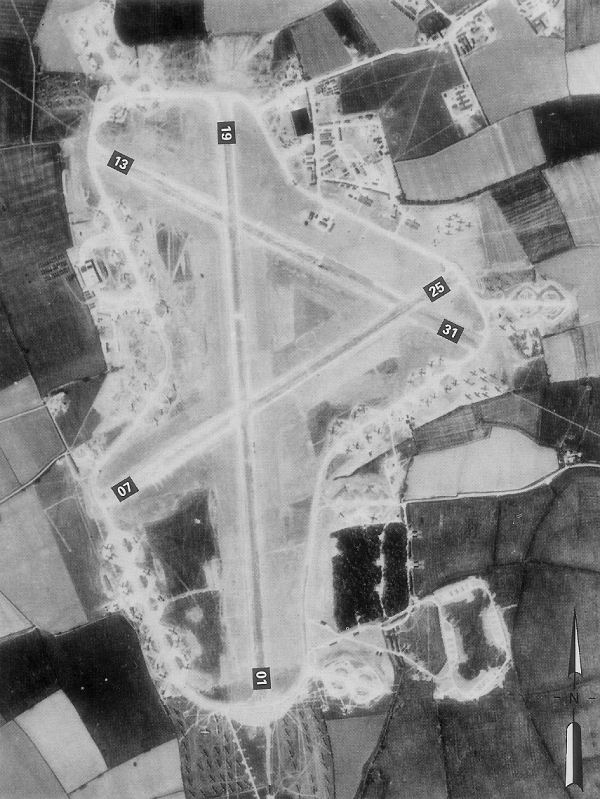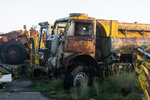An Introduction
It has been well known spot within this community for a while, which appears to have laid low for a few years, now with little to no reportage. It had been one of my many incomplete locations upon the county of Lincolnshire for a while as well.
About time to take a wonder.
The Visit
Being a breakers yard, with what one can only assume to be a vast wealth of metal laying there, it made sense to go a little early in the morning. This also had the added side effect of experiencing thick fog with no more than 50m visibility and providing greater time for a day of shenanigans.
A rather peaceful walk through the woods took along the remains of the Bomb Store up to the edge of the woods and to the field to the former parking apron.
Now occupied by tractors, deer and foxes.
We walked up past the warnings of shooting and began to take a closer look around among the waves of fog barrelling through.
There's no too much else to say really. It's a runway full of rusting plant, which makes for a relaxing wander.
Initially, being a runway full of rusting plant, I wasn't expecting to get any usable images. Turns out the fog and sunrise gave it a differing aesthetic to others.
A history
Formerly RAF Folkingham, now Nelson M Green Ltd.
Drone Image, Post Explore.

RAF Folkingham follows a similar history, within its origins, to many of Britain's RAF bases built during the midst of the second world war.
The base followed the same Copy and Paste design utilized by the RAF and the allied USAF for its now much larger aircraft requiring a hard surface to operate from than the grass fields required by thoes smaller and lighter aircraft prior. The layout of the base consisted of three runways forming an uppercase "A" when viewed from above with the instersecting runway being the longest and usually the main runway. Today the longer runaway, formerly reaching 6,000ft in length, is the only surving runway with the two smaller runways hard to make out.
Known best as a Class A airfield.
It has been well known spot within this community for a while, which appears to have laid low for a few years, now with little to no reportage. It had been one of my many incomplete locations upon the county of Lincolnshire for a while as well.
About time to take a wonder.
The Visit
Being a breakers yard, with what one can only assume to be a vast wealth of metal laying there, it made sense to go a little early in the morning. This also had the added side effect of experiencing thick fog with no more than 50m visibility and providing greater time for a day of shenanigans.
A rather peaceful walk through the woods took along the remains of the Bomb Store up to the edge of the woods and to the field to the former parking apron.
Now occupied by tractors, deer and foxes.
We walked up past the warnings of shooting and began to take a closer look around among the waves of fog barrelling through.
There's no too much else to say really. It's a runway full of rusting plant, which makes for a relaxing wander.
Initially, being a runway full of rusting plant, I wasn't expecting to get any usable images. Turns out the fog and sunrise gave it a differing aesthetic to others.
A history
Formerly RAF Folkingham, now Nelson M Green Ltd.
Drone Image, Post Explore.
RAF Folkingham follows a similar history, within its origins, to many of Britain's RAF bases built during the midst of the second world war.
The base followed the same Copy and Paste design utilized by the RAF and the allied USAF for its now much larger aircraft requiring a hard surface to operate from than the grass fields required by thoes smaller and lighter aircraft prior. The layout of the base consisted of three runways forming an uppercase "A" when viewed from above with the instersecting runway being the longest and usually the main runway. Today the longer runaway, formerly reaching 6,000ft in length, is the only surving runway with the two smaller runways hard to make out.
Known best as a Class A airfield.
As a side note of no actual value: take a look at Heathrow airport from satellite imagery and you can just about see the outline of the three runways it had as a RAF base, which now form part of the taxiways.

RAF Folkingham first opened in 1940 as a Decoy base for RAF Spital Gate.
A short while into its life, approx. 1943, the base was taken over by the USAF becoming station number 484. It was at this time the RAF designated the site as a Class A airfield and construction works finished in 1944 in time for the arrival of the 313th Troop Carrier Group which comprised of four squadrons.
The use of the base was short lived as the end of WW2 saw the the Squadron depart to France with most personnel having left in March 1945. That being said the base was retained by the USAF with personnel onsite until the USAF's full departure from the site in spring 1947.
The site was relieved of Military operations leaving it open for the use of BRM (British Racing Motors).
The newly formed BRM used the site as a facility to test their engines for the F1, specifically their somewhat radical 16-Cylinder 1.5 Litre Supercharged Engine which would comply with the motorsport regulations of the time. Engine's development proved difficult and would not fire until 1949 being shown to the press at Folkingham later that year.
Further Reading Here
BRM would occupy the airfield until 1958 when it was bought back into military service.
The RAF 223 Squadron was reformed in 1959 as a Strategic Missile Squadron who would conduct operations at RAF Folkingham using the Thor Missile System. The Thor missile was one of the earlier Ballistic Missile designs, first introduced to the USAF and only operated by two NATO nations. RAF Folkingham saw the operation of three of the Intermediate Range Ballistic Missiles until their decommissioning in 1963. This returned the Airfield to the BRM for a short period until the airfield was sold off for agricultural use with a large amount of the taxiways excavated for use as aggregate.
The remaining land would become home for stored agricultural vehicles which are stripped for their useful parts by Nelson M Green & Sons, a company formed in 1965.
Imagery
Having known of a van occasionally patrolling the former base and the aggression that is shown to trespassers we spent the first few moments gazing into the fog and listening out.
It didn't take to long to determine the coast was, more than likely, clear.
Approaching through the fog upon the edge of the apron.
It appeared visibility had improved for a short while.
Alot of the plant here had long since seen operation.
It took only a few moments to realise that shooting wide-angle with the tripod was a bit overkill. So much detail could be captured using other means.
This place often gets referred to as a "military vehicle graveyard" presumably, due to the word graveyard garnering the clicks a lot better, and the saturation of military plant that once occupied this area.
There was very little of the military variety left here.
Even for this small spur, just off the taxiway, there was easily enough to get exited about.
Then the Fog re-approached.
The Fog cleared remarkably quickly once the sun broke above the tree tops. Allowing an easier approach to the runway.
A lot of the cranes and big stuff was along this stretch.
Both side of the strip had a mix of yellow and rust.
The place had a rather soothing and non-threatening atmosphere.
The conditions had also improved by now giving much better visibility.
Some machinery was clearly more recent than other arrivals.
There was some militaryish equipment.
Things did become repetitive after a while.
Even though I had reached the end of the runway there was some items of interest.
With time carrying on it was time to grab some final images and depart.
And that'll be all.
Just a slab on concrete with some diggers.
KP_
Attachments
Last edited:



